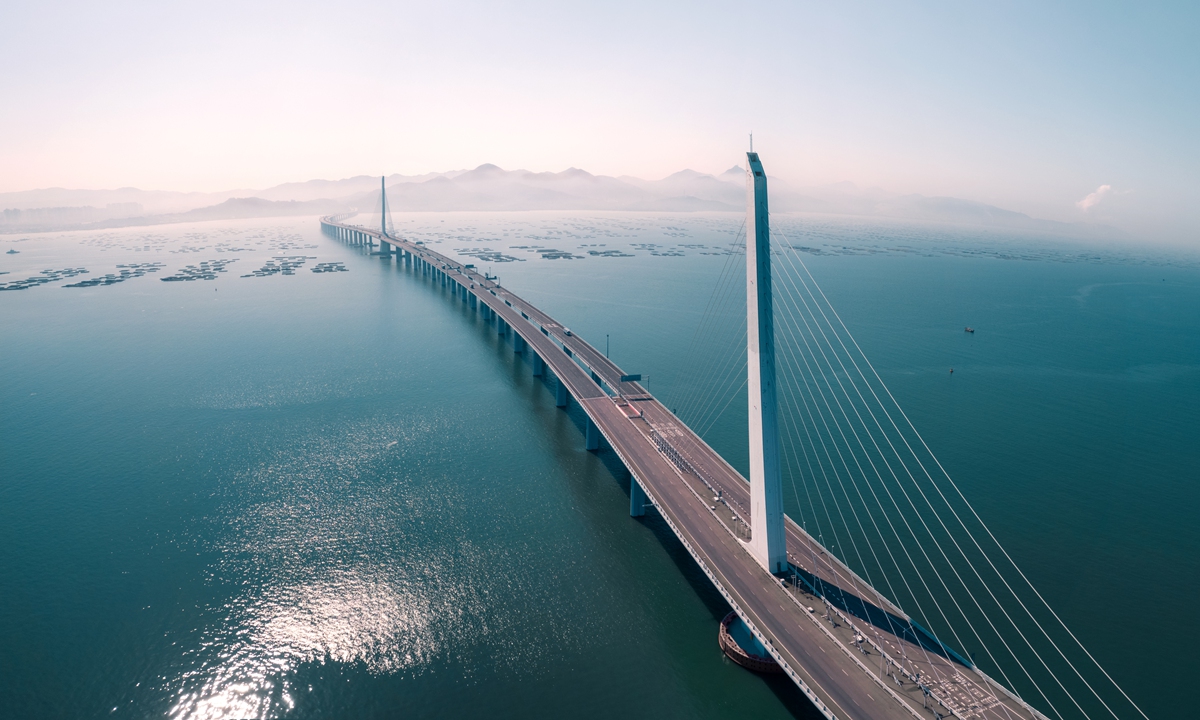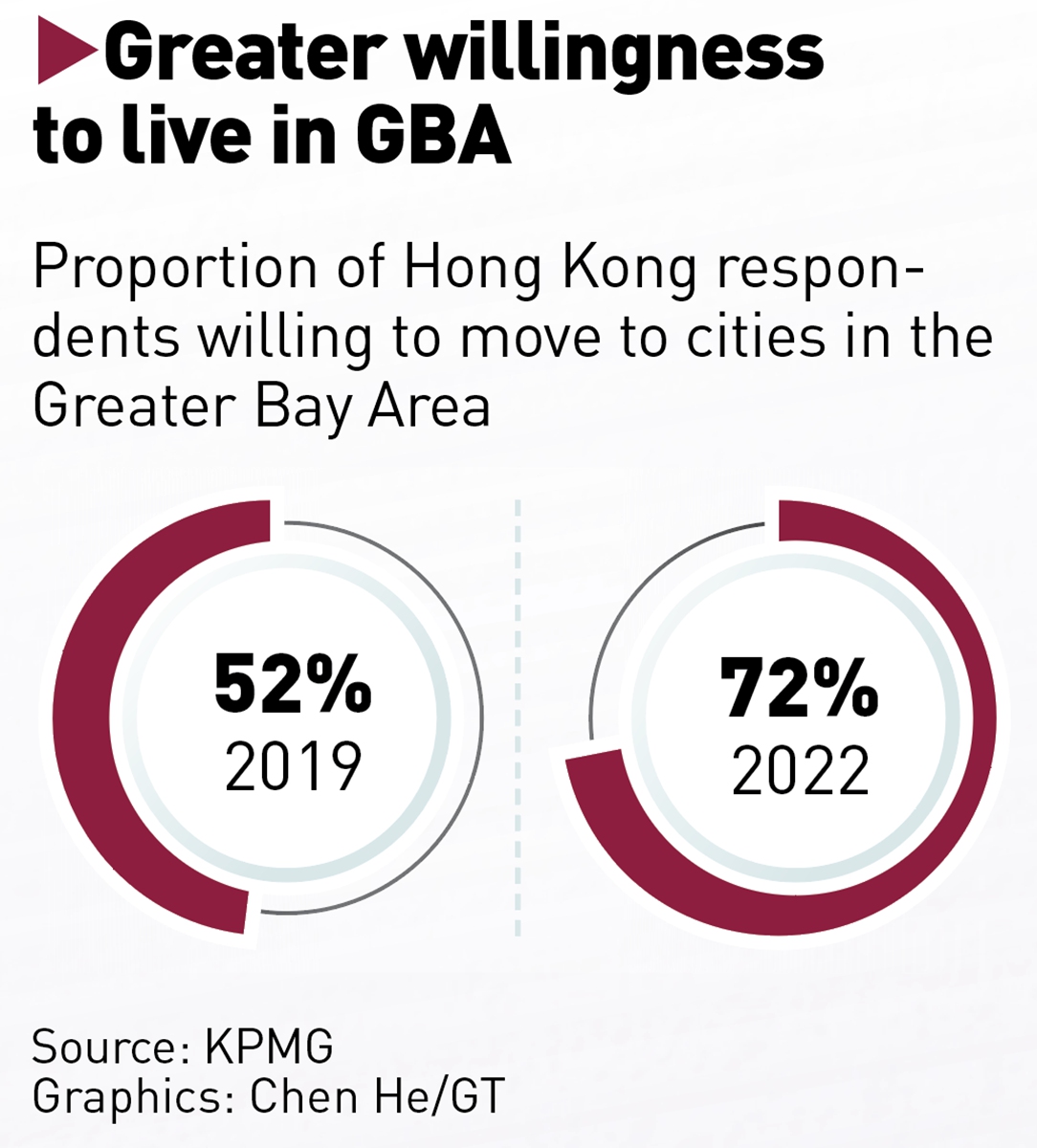
Aerial view of Shenzhen Bay Bridge Photo: VCG
On July 1, the bustling Victoria Harbor will be illuminated with glittering lights, decorating every corner of the metropolis. Across the port stands Hong Kong's iconic modern skyscraper international financial center, where market trading operates 24/7. Looking down from the Lion Rock Hill, the Sham Chun River, which borders Shenzhen on the mainland, is flowing, and Hongkongers are in a joyful mood to mark a special day with eager anticipation for a brighter future.
July 1 is a special date for Hong Kong. The special administrative region (SAR) has been on an extraordinary journey in the past quarter-century, after it returned to the motherland in 1997. The journey has been unprecedented, during which the vibrant cosmopolitan city has surmounted waves of headwinds, and thrived as a major international financial, trade and shipping hub.
The special day is not only a reflection of the past journey, which proves the "one country, two systems" principle is a success as Hong Kong fortified its role as a "super connector" between Chinese mainland and the world. It more importantly marks a new start: After facing a series of internal social and economic challenges as well as a volatile global environment, how should the SAR rekindle its new roles under the national development blueprint and better integrate with the mainland to ensure long-term prosperity?
While some traditional functions will continue to stand out, entrepreneurs and observers have high expectations on the future role of the SAR, which is positioned at the center of the Greater Bay Area (GBA) with a GDP of 12.6 trillion yuan ($1.99 trillion) that equates to that of South Korea. The city is set to leverage its inherent innovation and tech prowess in the Greater Bay Area and provide a bulwark against rising geopolitical tensions, so that it could maintain its prosperity and vigor while further channeling impulses into the growth of the world's second-largest economy.
'Super connector'
"If we traced back, many Hong Kong businessmen have 'earned the first barrel of gold' thanks to the city's role as 'super connector and an intermediate.' The SAR won't be able to earn such reputation as the global trade center without strong backing from the Chinese mainland, otherwise it could be marginalized in the global trade landscape," Michael Li Chi-fung, vice honorary secretary of the Hong Kong Chinese Importers' & Exporters' Association, told the Global Times.
The mainland has been the largest export market of Hong Kong for years. And many Hong Kong companies set up factories in the Chinese mainland taking advantage of latter's lower labor costs, and then exported the finished products back to Hong Kong which were then re-shipped to foreign destinations, Li explained.
Hong Kong's unique position also pans out in the financial front, as it has rule of law legal framework, a fully convertible currency, fully open capital markets and allows free movement of capital and other elements. The city has held its third position slot among the world's financial center, trailing only after New York and London, according to the Global Financial Centres Index published by London think tank Z/Yen and the China Development Institute.
"Taking advantage of the system, Hong Kong has prospered as a gateway of the Chinese mainland to the world, a pilot area that carried out reforms and a firewall against external financial uncertainties," Qi Mingyang, chairman of Shenzhen-based asset management firm Fortune Valley Capital Investment Group, told the Global Times.
Qi stressed that Hong Kong's financial role, looking ahead, is set to further consolidate, taking into account political factors, including the US' relentless crackdown on the Chinese tech industry and push for a financial decoupling with China, which has prompted the homecoming of notable US-listed Chinese firms.
"Hong Kong will in the next decade amplify its role as a buffer zone that reconciles interests of different parties," he said. Industry insiders also expected that the megacity could function as a "diving board" in the next decade, based upon its internationally recognized practices, not only trial more opening-up practices that are applicable to Chinese mainland but also aid Chinese capital and companies' global outreach.

Graphics: Chen He/GT
Strategically important roleHong Kong's embodiment of national strategy is further expanded and highlighted in the central government's national development blueprint. According to the national 14th Five-Year Plan (2021-25), the central government supports Hong Kong to cement its four traditional roles as global financial, shipping, trade center and global center for law and dispute settlement in the Asia-pacific region, while encouraging the city to explore four new roles, including serving as a global innovation and tech center, among other directions involving the services sector.
John Lee Ka-chiu, the sixth-term Chief Executive of HKSAR who takes office on July 1, has vowed that Hong Kong will harness its role as "eight centers" to the maximum, actively explore opportunities in the Greater Bay Area and better serve its position as the bridge that connect the Chinese mainland with the world.
"Some of Hong Kong's traditional functions have been waning, but the city is ideally positioned to shoulder a bigger responsibility in China's tech climb-up. It's a task that Shenzhen may not be able to assume but Hong Kong could do an 'addition'," an executive of Shenzhen-based leading tech firm, who spoke on condition of anonymity, told the Global Times, while taking note of the prospect of orchestrating a complete high-end manufacturing chain in the Greater Bay Area.
He noted that this positioning is of critical importance, as it's another effective means to counter Washington's unilateral blockade against China's rising tech industry.
The company, who saw one of its first product concepts being invented in the HKSAR, has already set up joint labs with Hong Kong universities - jumping on the bandwagon of many similar mainland companies such as Huawei and genetic sequencer MGI - to accelerate research and development (R&D) of new gadgets.
MGI, also an affiliate of China's genomics giant BGI Group, told the Global Times that Hong Kong can see its advantages as being "brain" of the Greater Bay Area, with global talents, scientific research quality and breakthrough research results that are crucial to the competitiveness of biotechnology cluster.
"Hong Kong excels in basic R&D and has a high level of internationalization, but is short in translating research results and massive production. In contrast, Guangdong is home to a complete industrial chain, so if the two regions' collaboration is synergized, it could generate a multiplying effect," Kris Tsang, a Hong Kong citizen who set up a start-up in Shenzhen six years ago, told the Global Times.
MGI also talked about building the Greater Bay Area into a high land for the bio-industry and related core equipment manufacturing base - an emerging industry with the national strategic significance. "There's more Hong Kong can do if we are now aiming for a global high land like Boston's ultra-dense industrial cluster, where the total number of life science companies and employees leads the US and global urban clusters." MGI said.
Hong Kong's Innovation and Technology Bureau said in a statement sent to the Global Times on Wednesday that the city possesses strong R&D and innovation capabilities, with forward-looking R&D talent as well as the ability to break through "from zero to one".
"As the 25th Anniversary of Hong Kong's return to the motherland is approaching, we are more confident than ever that we could fully collaborate in the development of the GBA by leveraging the complementary advantages among different cities in the GBA, and develop the GBA into an international information technology hub," the bureau said, noting that it will leverage "Hong Kong's strengths" to serve the needs of the country.
The construction of GBA - a massive national priority agenda that constitutes 11 cities with a combined population of over 80 million - was incubated three year ago and is now forged into a series of deliverable action plans that deepen comprehensive cooperation within the area, including promoting the development of Nansha District in Guangzhou, capital of Guangdong, Shenzhen's Qianhai and Macao's neighboring district Hengqin.
"Hong Kong is on trajectory to capitalize the huge opportunities presented by the Greater Bay Area. But it also needs to act beyond that and proactively integrate deeper with the mainland's development plan," Liang Haiming, dean of the Belt and Road Institute at Hainan University, told the Global Times.
For example, under the central government's dual-circulation strategy and the Belt and Road Initiative, "looking inland" has also drawn wide attention among Hong Kong businesses. "That means the GBA could also be developed into a base, paving way for Hong Kong companies to make inroads into China's Central and Western areas that show great market potential," Liang said.
According to Tsang, the pace of economic integration has been accelerating - starting with young people from Hong Kong, himself included, that migrate to the GBA to start a new career in the Chinese mainland. Li also hailed the national plan as a business booster, as he learned that plenty of Hong Kong businessmen have made a "deep adjustment" based on the national plan, which in turn improved their profitability.
"The implementation of the national security law for Hong Kong and the city's electoral reform helped restore social and economic order, which also provides a solid foundation for further integration with the Chinese mainland to gain steam in the near future," Liang said.

A glimpse of the Greater Bay Area development.Graphic:Xiong Xiaoying/GT,Editor:Huo Siyu/GT






